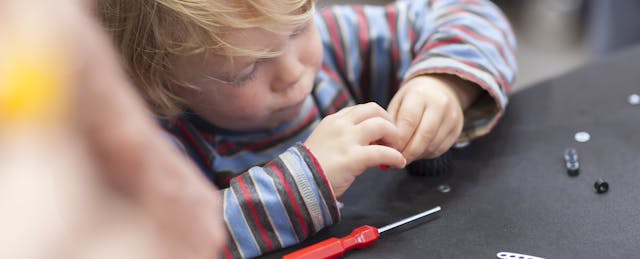The abrupt announcement of Maker Media’s shutdown startled and shocked people in many walks of life—especially educators who felt inspired to bring making and the do-it-yourself spirit into teaching and learning.
It also raised questions about what the future holds for the maker education movement, and particularly the Maker Education Initiative, which has provided professional development trainings and resources for seven years and counting.
The short answer: The nonprofit’s work will not be impacted in any way, pledges Kyle Conforth, executive director of the Maker Education Initiative.
While the Maker Education Initiative shares a namesake, founder and guiding ethos with Maker Media, it is a wholly separate operation. (Maker Media was a for-profit company that had raised $10 million in venture and debt capital.) Dale Dougherty, founder and CEO of Maker Media, is on the board of Maker Education Initiative but has no day-to-day involvement.
“We are born from—but not fiscally or legally connected to—Maker Media,” Conforth states in an interview with EdSurge.
The Maker Education Initiative started in 2012, when individuals and organizations reached out to Dougherty, eager to bring maker education programs to schools. According to Conforth, setting up the Maker Education Initiative in the nonprofit sector made it easy to accept philanthropic support for the work. Intel, Cognizant and O’Reilly Media were its first chief backers.
The Maker Education Initiative operates as a project of the Tides Center, a San Francisco-based incubator of social-impact nonprofit organizations. Tides manages some of the backend administrative and operational work for the Maker Education Initiative, and acts as its fiscal sponsor for fundraising purposes.
Currently, Conforth shares, Maker Education Initiative has an operating budget of around $1.5 million, funded by donations and fees from services it provides. It has a full-time team of nine. Last year, its biggest donors included Google, Cognizant, Chevron and the National Science Foundation.
Since its beginning, the Maker Education Initiative has organized maker education workshops for kids and adults across the country. It has established 21 regional “hubs” across the U.S. where it regularly organizes these activities, which take place in schools, libraries, museums and other community organizations. And each year it hosts an annual convening for maker educators from across the world; the next one is slated for October, in Pittsburgh.
In addition, the group offers online and in-person trainings for educators across the country interested in weaving maker pedagogy into their curriculum, assessment and instructional practices. There is also a library of free online resources of project plans and playbooks for integrating maker activities into everyday educational settings.
In the past five years, the group claims its work has reached nearly a quarter million teachers, kids and families across hundreds of events.
All of these activities will continue without interruption, says Conforth. If anything, she shares, “our work is picking up even faster, and it’s been hard keeping up with demand.” Case in point: after facilitating a workshop this January for a handful of teachers and principals from the Oakland Unified School District, the district has asked the team to return and provide the same training to other educators across the entire district.
Conforth says she wasn’t entirely caught off guard by Maker Media’s financial problems, adding that Dougherty had shared publicly last year that Maker Media was having difficulty securing sponsorships. “I knew the business was struggling,” she says.
“It’s sad to see a business fail, especially when that business was trying to represent a movement,” she adds. “Our hearts go out to Dale.”
In a note about the closure of Maker Media, the Maker Education Initiative wrote:
We know that the maker spirit will live on in thousands of makers and makerspaces, and that it has left an indelible, vibrant, and ongoing legacy on the cultural landscape. Maker Ed is especially indebted to the influence making has had on education, as it connects to and builds on long legacies of constructivism, constructionism, Montessori, Papert, and other frameworks that understand that kids learn best when they use their hands, hearts, and heads; when they work in collaboration and in community; when their agency is put at the center of learning; and when their gifts are recognized and their needs are met. We deeply believe that creativity and hands-on learning have the potential to transform schools for the better.


